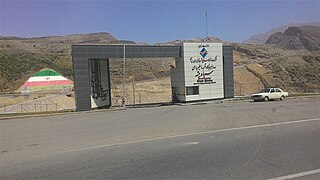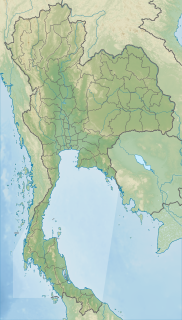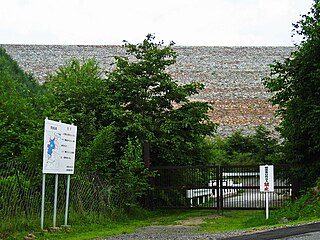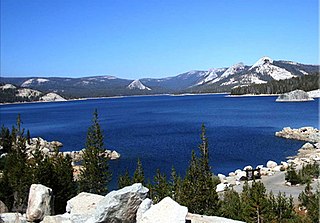| Upper Cisokan Pumped Storage Power Plant | |
|---|---|
| Official name | Upper Cisokan Pumped Storage Hydro Electric Power Plant |
| Country | Indonesia |
| Location | West Java |
| Coordinates | 6°56′52″S107°13′07″E / 6.94778°S 107.21861°E Coordinates: 6°56′52″S107°13′07″E / 6.94778°S 107.21861°E |
| Status | Proposed |
| Opening date | 2025 (est.) |
| Construction cost | US$800 million |
| Owner(s) | Perusahaan Listrik Negara |
| Upper reservoir | |
| Creates | Cirumamis Reservoir |
| Total capacity | 14,000,000 m3 (11,350 acre⋅ft) |
| Lower reservoir | |
| Creates | Cisokan Reservoir |
| Total capacity | 63,000,000 m3 (51,075 acre⋅ft) |
| Power Station | |
| Hydraulic head | 276 m (906 ft) |
| Pump-generators | 4 x 260 MW (275 MW in pump-mode) Francis pump-turbines |
| Installed capacity | 1,040 MW |
The Upper Cisokan Pumped Storage Plant is a proposed pumped-storage hydropower facility in Indonesia, due for completion by 2025. [1]
The pant will be located 40 km (25 mi) west of Bandung in West Java, Indonesia, and its two reservoirs will occupy area in West Bandung Regency and Cianjur Regency. [2] It will have an installed capacity of 1,040 MW and will be Indonesia's first pumped-storage power plant.
Studies for the project were carried out in the 1990s and a detailed design was completed in 2002. A World Bank loan for the project was approved in May 2011 and signed in November. The West Java government approved the project in October 2011. Preliminary construction such as access road building began in early 2014. [3] [4] The first generator was then expected to be operational by 2019. [5] [6] [7]
However, the project has been delayed and the loan was cancelled in May 2017. Construction did not start partly due to the occurrence of landslides. The access road has been built but is considered unsafe. [8] In 2019, a new loan agreement with the World bank was found, and the facility was expected to become operational by 2025, according to Indonesia's Electricity Supply Business Plan. [1]
Of the project's US$800 million cost, US$650 million is being provided by the World Bank. The remaining US$150 million is to be supplied by the project owner Perusahaan Listrik Negara. [1] [9]
The power plant will operate by shifting water between two reservoirs; the lower reservoir on the Upper Cisokan River (a branch of the Citarum River), and the upper reservoir on the Cirumamis River which is a right-bank tributary of the former. [10] [11] When energy demand is high, water from the upper reservoir is sent to the power plant to produce electricity. When energy demand is low, water is pumped from the lower reservoir to the upper by the same pump-generators. This process repeats as needed and allows the plant to serve as a peaking power plant. [10]
Both reservoirs will be formed by concrete gravity dams using roller-compacted concrete. Each will have an overflow spillway at the center of their center. The upper reservoir's dam will be 75.5 m (248 ft) tall and 375 m (1,230 ft) long while the lower reservoir dam will be 98 m (322 ft) high and 294 m (965 ft) in length. The lower reservoir dam will trap water from a 355 km2 (137 sq mi) catchment area to create a lake with a gross storage capacity of 63,000,000 m3 (51,075 acre⋅ft). Of the total capacity, 10,000,000 m3 (8,107 acre⋅ft) can be used for pumping up to the upper reservoir. The surface area of the lower reservoir will be 260 ha (1 sq mi). The upper reservoir dam will trap water from a much smaller catchment area, 10.5 km2 (4 sq mi), to create its reservoir with a gross storage capacity of 14,000,000 m3 (11,350 acre⋅ft) and surface area of 80 ha (0 sq mi). Of that capacity, 10,000,000 m3 (8,107 acre⋅ft) is active (or usable) storage for power generation. [10]
The power plant will be located underground near the lower reservoir. Connecting the upper reservoir and the power plant will first be two headrace tunnels, one 1,220 m (4,003 ft) long and the other 1,160 m (3,806 ft) in length. Surge tanks on each headrace tunnel help prevent water hammer. Each headrace tunnel connects to a steel-lined penstock, each of which later bifurcates into two penstocks. Each of these four penstocks will supply water to the turbines during power generation. After power generation the water will be discharged into the lower reservoir via four tailrace tunnels. When pumping water moves through the same conduits back to the upper reservoir. The power plant will contain four Francis pump-turbines which are rated at 260 MW each for power generation and 275 MW for pumping. The upper reservoir will lie at maximum elevation of 796 m (2,612 ft) and the lower at 499 m (1,637 ft). This difference in elevation will afford the power plant a rated hydraulic head of 276 m (906 ft). [10]
The Ingula Pumped Storage Scheme is a pumped-storage power station in the escarpment of the Little Drakensberg range straddling the border of the KwaZulu-Natal and Free State provinces, South Africa. It is about 22 km (14 mi) North-East of Van Reenen.

The Siah Bisheh Pumped Storage Power Plant, also spelled Siyāhbisheh and Siah Bishe, is located in the Alborz Mountain range near the village of Siah Bisheh and 48 km (30 mi) south of Chalus in Mazandaran Province, Iran. The power plant uses the pumped-storage hydroelectric method to generate electricity during periods of high energy demand, making it a peaking power plant, intended to fulfill peak electricity demand in Tehran 60 km (37 mi) to the south. When complete it will have an installed generating capacity of 1,040 megawatts (1,390,000 hp) and a pumping capacity of 940 megawatts (1,260,000 hp). Planning for the project began in the 1970s and construction began in 1985. It was delayed from 1992 until 2001 and the first generator went online in May 2013. The remaining generators were commissioned by 1 September 2015. The power plant is the first pumped-storage type in Iran and will also use the country's first concrete-face rock-fill dam – two of them.

The Kannagawa Hydropower Plant (神流川発電所) is an under construction pumped-storage hydroelectric power plant near Minamiaiki in Nagano Prefecture and Ueno in Gunma Prefecture, Japan. The power plant utilizes the Minamiaiki River along with an upper and lower reservoir created by two dams, the upper Minamiaiki Dam and the lower Ueno Dam. The power station in between the two dams will contain six 470 megawatts (630,000 hp) pump-generators for a total installed capacity of 2,820 megawatts (3,780,000 hp). Unit 1 commenced commercial operation in 2005 and Unit 2 in 2012. When completed, the plant will have the second-largest pumped-storage power capacity in the world.

The Kölnbrein Dam is an arch dam in the Hohe Tauern range within Carinthia, Austria. It was constructed between 1971 and 1979 and at 200 metres (660 ft) high, it is the tallest dam in Austria. The dam's reservoir serves as the primary storage in a three-stage pumped-storage power system that consists of nine dams, four hydroelectric power plants and a series of pipeline and penstocks. The complex is owned by Verbund power company and is referred to as the Malta-Reisseck Power Plant Group. The installed capacity of the group is 1,028.5 MW and its annual generation is 1,216 gigawatt-hours (4,380 TJ).

The Lam Takhong Dam is an embankment dam on the Lam Takhong River between Pak Chong District and Sikhio District in Nakhon Ratchasima Province, Thailand. The dam was originally constructed in 1974 for the purposes of irrigation and water supply but after 2002, its water storage also serves as the lower reservoir for the Lam Takhong pumped storage power plant, Thailand's first power plant of that type.

The Kazunogawa Pumped Storage Power Station is a pumped-storage hydroelectric power station near Kōshū in Yamanashi Prefecture, Japan. The station is designed to have an installed capacity of 1,600 megawatts (2,100,000 hp) and three of the four 400 megawatts (540,000 hp) generators are currently operational, for a total operational capacity of 1200 MW. Construction on the power station began in 1993 and the first generator was commissioned on 3 December 1999. The second was commissioned on 8 June 2000. The third on become operational on 9 June 2014, six year early due to post-power demand from the Great East Japan earthquake. The fourth and final generator is slate to be commissioned by 2024. It is owned by TEPCO and was constructed at a cost of US$2.2 billion.

The Grand'Maison Dam is an embankment dam on L'Eau d'Olle, a tributary of the Romanche River. It is located in Vaujany of Isère within the French Alps. The primary purpose of the dam is to serve as the upper reservoir for a pumped-storage hydroelectric scheme where Lac du Verney located lower in the valley is the lower reservoir. The dam was constructed between 1978 and 1985 with its power station being commissioned in 1987. With an installed capacity of 1,800 MW, it is the largest hydroelectric power station in France.

The Helms Pumped Storage Plant is located 50 mi (80 km) east of Fresno, California in the Sierra Nevada Mountain Range's Sierra National Forest. It is a power station that uses Helms Creek canyon on the North Fork of the Kings River for off-river water storage and the pumped-storage hydroelectric method to generate electricity. After being planned in the early 1970s, construction on the plant began in June 1977 and commercial operations began on 30 June 1984. It has an installed capacity of 1,212 MW and is owned by Pacific Gas and Electric Company.

The Jatigede Dam is an embankment dam on the Cimanuk River in Sumedang Regency, West Java, Indonesia. It is located 19 km (12 mi) east of the town of Sumedang. Construction on the dam began in 2008 and it was completed in 2015. The power station is expected to be commissioned in 2019. The primary purpose of the dam is irrigation but it will also provide for flood control, water supply and hydroelectric power generation. Water in the reservoir will be used to help irrigate 90,000 ha of farmland and the power station is expected to have a 110 MW capacity. The project has been become controversial, primarily due to the relocation of people in the future reservoir zone.

The Edolo Pumped Storage Plant is located along the Oglio River just downstream of Edolo, Brescia Province in the Lombardy region of Italy. Using the pumped-storage hydroelectric method, it has an installed capacity of 1,000 megawatts (1,300,000 hp). Its generators were commissioned between April 1984 and November 1985. Lake Avio was previously completed in 1929 and Lake Benedetto completed in 1940.

The Rocky Mountain Hydroelectric Plant is a pumped-storage power plant located 10 miles (16 km) northwest of Rome in the U.S. state of Georgia. It is named after Rock Mountain on top of which the plant's upper reservoir is located. Construction on the plant began in 1977 and it was commissioned in 1995. After upgrades were completed in 2011, the plant has an installed capacity of 1,095 megawatts (1,468,000 hp). It is owned by both Oglethorpe Power and Georgia Power which have 75 percent and 25 percent stakes, respectively.

The Vianden Pumped Storage Plant is located just north of Vianden in Diekirch District, Luxembourg. The power plant uses the pumped-storage hydroelectric method to generate electricity and serves as a peaking power plant. Its lower reservoir is located on the Our River, bordering Germany, and the upper is elevated above on the nearby Saint Nicholas Mountain. Construction on the plant began in 1959 and the first pump-generators were commissioned in 1962. A tenth pump-generator was installed in 1976 bringing the plant's installed generating capacity to 1,096 megawatts (1,470,000 hp). The plant generates an average of 1,650 gigawatt-hours (5,900 TJ) annually but of course consumes even more. Generally the efficiency of this energy storage method is around 70-80%. The plant is owned by Société électrique de l'Our and RWE. Construction on an eleventh pump-generator began in 2010 and it is expected to be commissioned in 2013, which will bring the plant's installed capacity to 1,296 megawatts (1,738,000 hp).
The Xilongchi Pumped Storage Power Station is a pumped-storage hydroelectric power station located 50 km (31 mi) east of Xinzhou in Wutai County of Shanxi Province, China. It was constructed between 2001 and 2008. The power station operates by shifting water between an upper and lower reservoir to generate electricity. The lower reservoir was formed with the creation of the Xilongchi Lower Dam. The Xilongchi Upper Reservoir is located high atop a mountain above the northeast side of the lower reservoir. Both reservoirs are located between the confluence of the Hutuo and Qingshui Rivers. During periods of low energy demand, such as at night, water is pumped from Xilongchi Lower Reservoir up to the upper reservoir. When energy demand is high, the water is released back down to the lower reservoir but the pump turbines that pumped the water up now reverse mode and serve as generators to produce electricity. The process is repeated as necessary and the plant serves as a peaking power plant.
The Tongbai Pumped Storage Power Station is a pumped-storage hydroelectric power station located 6 kilometres (3.7 mi) north of Tiantai city in Tiantai County of Zhejiang Province, China. Construction on the power station began in May 2000 and the first unit was commissioned in December 2005. The remaining three were operational by December 2006. The entire project cost US$904.10 million, of which US$320 million was provided by the World Bank. The power station operates by shifting water between an upper and lower reservoir to generate electricity. The lower reservoir was formed with the creation of the Tongbai Lower Dam on the Baizhang River. The Tongbai Upper Reservoir, which already existed before construction began, is in an adjacent valley above the east side of the lower reservoir on Tongbai Creek. During periods of low energy demand, such as at night, water is pumped from Tongbai Lower Reservoir up to the upper reservoir. When energy demand is high, the water is released back down to the lower reservoir but the pump turbines that pumped the water up now reverse mode and serve as generators to produce electricity. The process is repeated as necessary and the plant serves as a peaking power plant. The power station is operated by Shenergy Company.
The Zhanghewan Pumped Storage Power Station is a pumped-storage hydroelectric power station located 50 km (31 mi) southwest of Shijiazhuang in Jingxing County of Hebei Province, China. Construction on the power station began on 6 December 2003 and the first unit was commissioned on 1 February 2009. The power station operates by shifting water between an upper and lower reservoir to generate electricity. The lower reservoir is created by the Zhanghewan Dam on the Gantao River which was built between 1977 and 1980, originally for irrigation. For this project the Zhanhewan Dam was raised 23 m (75 ft). The Zhanghewan Upper Reservoir is on Laoyemiao Mountain, above the west side of the lower reservoir. During periods of low energy demand, such as at night, water is pumped from Zhanghewan Lower Reservoir up to the upper reservoir. When energy demand is high, the water is released back down to the lower reservoir but the pump turbines that pumped the water up now reverse mode and serve as generators to produce electricity. The process is repeated as necessary and the plant serves as a peaking power plant.
The Tai'an Pumped Storage Power Station is a 1,000 MW pumped-storage hydroelectric power station located in the city of Tai'an in Shandong Province, China. Construction on the project began in February 2000 and the upper reservoir began to fill in May 2005. The four generators were commissioned between December 2005 and August 2007. The power station operates by shifting water between an upper and lower reservoir to generate electricity. The lower reservoir, Dahe Reservoir, was originally built in 1960 but repaired extensively for the project. The Tai'an Upper Reservoir is located in a valley above the east side of the lower reservoir. During periods of low energy demand, such as at night, water is pumped from Tai'an Lower Reservoir up to the upper reservoir. When energy demand is high, the water is released back down to the lower reservoir but the pump turbines that pumped the water up now reverse mode and serve as generators to produce electricity. The process is repeated as necessary and the plant serves as a peaking power plant. It is operated by State Grid Xinyuan Co.
The Hongping Pumped Storage Power Station is a 1,200 MW pumped-storage hydroelectric power station currently under construction about 11 km (6.8 mi) northwest of Hongping in Jing'an County of Jiangxi Province, China. Construction on the project began in June 2010. The first generator was commissioned in June 2014 and a second 1,200 MW phase is planned for completion in 2017. When fully operational, the power station will have an installed capacity of 2,400 MW. The power station operates by shifting water between an upper and lower reservoir to generate electricity. The lower reservoir is located on Hebei River and the upper reservoir is located in a valley above the north side of the lower reservoir. During periods of low energy demand, such as at night, water is pumped from Hongping Lower Reservoir up to the upper reservoir. When energy demand is high, the water is released back down to the lower reservoir but the pump turbines that pumped the water up now reverse mode and serve as generators to produce electricity. The process is repeated as necessary and the plant serves as a peaking power plant. It is operated by Jiangxi Hongping Pumped Storage Ltd.
The Huanggou Pumped Storage Power Station is a 1,200 MW pumped-storage hydroelectric power station currently under construction about 90 km (56 mi) north of Mudanjiang in Hailin County of Heilongjiang Province, China. Construction on the project began on 8 May 2014. The first generator is scheduled to be commissioned in January 2019 and the project complete in January 2020. The power station operates by shifting water between an upper and lower reservoir to generate electricity. The lower reservoir, Lianhua Reservoir, is located on the Mudan River and the upper reservoir is located in a valley above the north side of the lower reservoir. During periods of low energy demand, such as at night, water is pumped from Huanggou Lower Reservoir up to the upper reservoir. When energy demand is high, the water is released back down to the lower reservoir but the pump turbines that pumped the water up now reverse mode and serve as generators to produce electricity. The process is repeated as necessary and the plant serves as a peaking power plant. It is operated by the State Grid Corporation of China.

The Nant de Drance Hydropower Plant is a pumped-storage power station currently being constructed in the canton of Valais in Switzerland. It is within the municipality of Finhaut, district of Saint-Maurice and about 14 km (8.7 mi) southwest of Martigny. Construction on the power plant began in 2008 and it should begin operations in 2020, for a completion in mid-2021. It is owned by Nant de Drance SA, a consortium of Alpiq (39%), SBB (36%), Industrielle Werke Basel (IWB) (15%) and Forces Motrices Valaisannes (FMV) (10%). When complete, the US$1.9 billion plant will have an installed capacity of 900 MW.
Nenskra Hydro Power Plant is a proposed hydroelectric power station to be located on the southern slopes of the Central Caucasus mountains in Svaneti, Georgia.